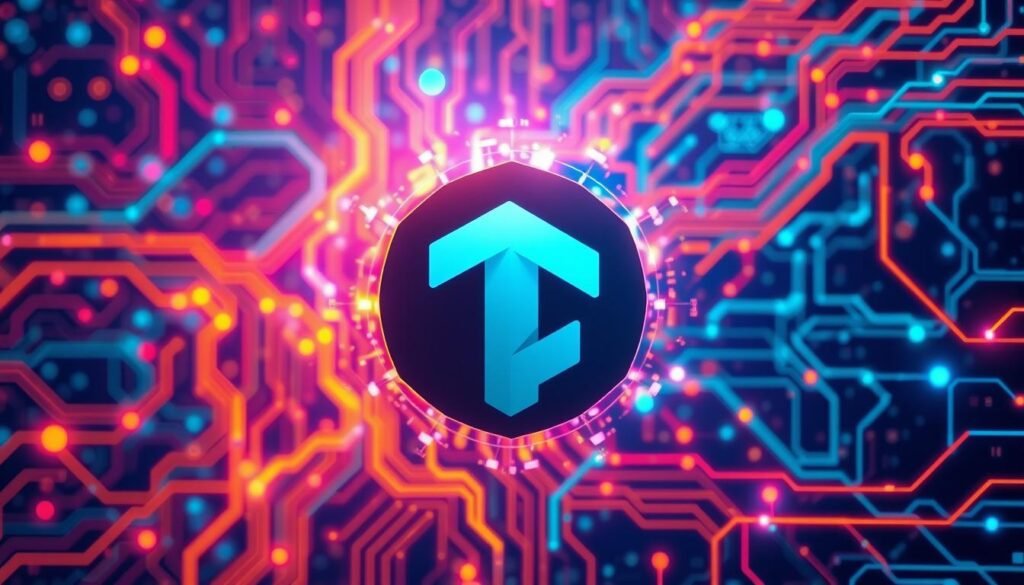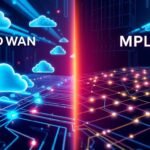Are you a developer wanting to use artificial intelligence (AI) and machine learning (ML) in your next project? AI technology is advancing fast. It’s key to know the top AI frameworks to make your development easier and your apps smarter. We’ll examine the leading AI frameworks that are revolutionizing the way developers create intelligent apps.
By 2025, experts expect the global AI market to reach $126 billion. Already, 37% of companies have started using AI. AI frameworks are the key parts that make building complex, smart systems easier. They offer pre-made functions, libraries, and tools. This cuts down on development time and makes AI modeling consistent across different platforms and apps.
Key Takeaways
- Understand the role of AI frameworks in streamlining the development of intelligent applications
- Discover the top AI frameworks that are transforming the developer landscape
- Explore the key features and benefits of using these AI frameworks
- Learn how to choose the right AI framework based on your project requirements
- Gain insights into the latest trends and advancements in the AI framework ecosystem
Understanding AI Frameworks and Their Impact
Artificial intelligence (AI) is now a key part of software development. Developers look for tools to add AI to their apps. AI frameworks help by providing a structured way to use AI in apps.
What Are AI Frameworks?
AI frameworks are sets of tools and libraries for building AI apps. They help in making, training, and using machine learning models. They also support AI features like understanding language, seeing images, and predicting outcomes.
The Evolution of AI Development Tools
The tools for AI development have changed a lot. They used to be complex and challenging to use. Now, there are easier, higher-level frameworks like TensorFlow, PyTorch, and Keras. These make using AI simpler, even for those new to it.
Benefits of Using AI Frameworks
Using AI frameworks has many benefits:
- They make developing AI apps faster and easier.
- They help make code better and easier to maintain.
- They make AI development open to more people, encouraging new ideas.
- They make it simple to add AI to existing projects.
By using AI frameworks, developers can work faster and make smarter apps. This helps them deliver better experiences to users.
Essential Components of AI Development Environment
Building strong artificial intelligence (AI) apps needs a suitable development setup. This setup must have key parts for AI model use, neural networks, and data prep. Let’s look at these main parts and why they’re important in AI.
High-Quality Data for Training and Testing
Good AI starts with quality data. This data is key for training and checking AI models. It makes sure they work well and are reliable. Getting and preparing this data right is very important.
Powerful Algorithms and Frameworks
The tools and frameworks in your AI setup are very important. They help your AI models work well and grow. You might use machine learning, deep learning, and other advanced methods for this.
Robust Computing Infrastructure
AI needs a lot of computing power. This can come from special hardware like GPUs or TPUs. Cloud services like AWS and Google Cloud also offer flexible computing for AI.
| Component | Description |
|---|---|
| Data | High-quality, relevant data for training and testing AI models |
| Algorithms | Mathematical models and methods for training and analyzing data, including machine learning, deep learning, NLP, and computer vision |
| Computing Infrastructure | Powerful hardware like GPUs or TPUs and scalable cloud-based services for efficient AI model deployment |
These essential components contribute significantly to a robust AI setup. This setup is key for deploying AI models, neural networks, and data prep.
AI Frameworks for Developers: Key Selection Criteria
When picking an AI framework, developers need to think about a few key things. These include how well the framework performs, the support it gets from the community, and how simple it is to use. These factors help make sure the AI tools fit the project’s needs and work well.
Performance Considerations
AI frameworks must handle big datasets and process information quickly. They need to scale well, work in parallel, and manage memory efficiently. This ensures the AI model runs smoothly and fast.
Community Support and Documentation
The strength of an AI framework’s community and its documentation is very important. A strong community offers support, shares tips, and helps improve the framework. This makes development easier and more effective.
Learning Curve and Ease of Use
The framework’s ease of use affects how quickly developers can start working on AI projects. Frameworks with clear interfaces and adequate documentation help developers learn faster. This speeds up the development process.
By looking at these key points, developers can find the right AI framework for their projects. This ensures they can use AI to create smart and innovative apps.
| AI Framework | Performance | Community Support | Ease of Use |
|---|---|---|---|
| TensorFlow | Highly scalable, supports distributed computing | Large and active community, extensive documentation | Steep learning curve, but offers high-level APIs like Keras |
| PyTorch | Efficient memory management, dynamic computational graphs | Growing community, strong support for research and rapid prototyping | Intuitive interface, modular API, and excellent for experimentation |
| Scikit-learn | Optimized for structured data, high-performance machine learning | Large and active community, extensive documentation | User-friendly, suitable for beginners in AI and machine learning |
Choosing the right AI framework depends on your project’s needs. It’s about finding a balance between performance, community support, and ease of use. This ensures your AI applications work well.
“The selection of the appropriate neural network library is vital for the success of AI development projects, ensuring that specific requirements are met while leveraging the functionalities offered by each library.”
TensorFlow: Google’s Powerful AI Framework
TensorFlow was created by Google’s Brain Team. It’s a popular open-source AI framework for making machine learning models. It’s great for tasks like language translation and facial recognition.
TensorFlow has an interactive user interface. It works on many platforms, letting developers see how models are doing. It’s flexible and works well with both CPUs and GPUs, making it easy to train and build models.
TensorFlow is also very customizable. Users can adjust it to fit their project needs. This makes it a versatile tool for many tasks.
TensorFlow, the Google AI framework, has a lot of data tools. These tools help clean and prepare data for use in models. It also supports distributed training and easy debugging with Keras.
TensorFlow Hub offers pre-trained models. This makes it easier to develop and deploy models. It saves time and effort.
TensorFlow Serving runs ML models at a large scale. It works on many processors, including Google’s custom TPUs. This ensures smooth integration with big systems.
The LiteRT framework lets models run on mobile devices and edge computing devices. This makes TensorFlow’s reach even wider.
| TensorFlow Features | Description |
|---|---|
| TensorFlow.js | Enables running machine learning models in web browsers |
| TFX | Provides software frameworks and tooling for full MLOps deployments |
| TensorFlow Lite | Allows for running models on mobile devices and edge computing devices |
TensorFlow needs some knowledge of machine learning. But its wide range of tools and libraries makes it a top choice for developers. It’s a powerful tool for artificial intelligence in projects.
“TensorFlow provides an easy way to create machine learning models that are capable of running in any environment.”
PyTorch: Deep Learning with Dynamic Graphs
PyTorch, made by Meta AI, is a top deep learning framework. It’s known for being easy to use and quick to prototype. Unlike other frameworks, PyTorch uses dynamic graphs. This lets developers change models easily. It’s why many researchers and practitioners choose PyTorch for deep learning.
Dynamic Computational Graphs
PyTorch’s dynamic graphs change the game in deep learning. You don’t have to set up the model structure beforehand. Instead, you can build and tweak it while it runs. This makes it easy to try out new ideas, improve models fast, and find bugs quickly.
Python Integration Features
PyTorch works great with Python, a favorite language in AI and machine learning. Its Pythonic design makes coding simpler. You spend less time on basic stuff and more on the important parts of building and training models.
Use Cases and Applications
- Computer vision: PyTorch is great for tasks like image classification, object detection, and segmentation.
- Natural Language Processing (NLP): It excels in text classification, language modeling, and machine translation.
- Generative Adversarial Networks (GANs): PyTorch is perfect for training complex generative models.
- Reinforcement Learning: Its flexibility is great for creating reinforcement learning agents and algorithms.
PyTorch is a great choice for anyone working with deep learning. Its easy-to-use interface, dynamic graphs, and strong Python integration make it ideal for creating advanced applications.
“PyTorch’s dynamic computational graphs provide the flexibility to rapidly prototype and iterate on deep learning models, making it a preferred choice for researchers and developers alike.”
Keras: High-Level Neural Network Library
Keras is a top-notch, high-level neural network library in Python. It’s known for being easy to use and understand. It’s a favorite Python AI framework because of its simplicity and flexibility. Plus, it works well with TensorFlow, making it even more powerful.
Building and managing neural network models is easier with Keras. Its design makes it simple to debug and maintain code. It supports many models and comes with a big library of layers and functions.
Keras is excellent for both beginners and experts in neural networks. It’s simple to learn and supports many backends for computation. This makes it very adaptable and flexible.
Recently, Keras has become available for JAX, TensorFlow, and PyTorch. This has made it even more popular. Big names like CERN, NASA, and NIH use it for its flexibility and convenience.
Companies like Netflix, Uber, Square, and Yelp also use Keras. They like how it makes deploying products easier. The Keras community is big and supportive, with lots of documentation and help.
“Keras brings a clear, consistent API and a common way of expressing modeling ideas to 8 teams across the major surfaces of YouTube recommendations.”
In short, Keras is a high-level neural network library in Python. It makes building and managing complex models easier. Its design, flexibility, and community support make it a top choice for Python AI framework developers.
MicrosoftCognitive Toolkit (CNTK): Enterprise-Grade AI
The Microsoft Cognitive Toolkit (CNTK) is a top-notch AI framework for big business needs. Microsoft is the maker of this framework, which boasts a wealth of features suitable for large-scale AI projects. It’s a fantastic pick for companies wanting to use AI on a big scale.
Core Features and Capabilities
CNTK works with many AI models, like deep neural networks and convolutional nets. It’s open-source, so developers can make it their own. Recent updates have made it faster, cutting down GPU and CPU times by a lot.
Integration with Azure Services
CNTK works well with Microsoft’s Azure cloud. This lets businesses build and manage AI in the cloud easily. Azure’s strong tools and infrastructure help make AI solutions better.
Performance Benchmarks
CNTK performs well in tests, making it suitable for tough AI tasks. It keeps getting better with updates to its operations. This makes it more efficient and accurate.
In short, CNTK is a top choice for big AI projects. It has great features and works well with Azure. It’s ready for big business AI needs.
Scikit-learn: Machine Learning Made Simple
Scikit-learn is a Python machine learning framework. It offers tools for tasks like classification, regression, and clustering. It’s great for small projects and quick tests.
Scikit-learn has many algorithms and preprocessing tools. This makes it easy to solve different machine learning problems. It also works well with NumPy, SciPy, and Matplotlib, making it a top choice for data analysis tools and Python machine learning projects.
| Scikit-learn Features | Industry Applications | Challenges |
|---|---|---|
|
|
|
Scikit-learn is known for its simplicity and versatility. But it has its limits. It’s not great for deep learning or handling very large datasets. Also, integrating it with some tools can be tricky.
Despite these challenges, Scikit-learn is very popular. It’s a key tool for machine learning because of its ease of use and integration with Python libraries. Its community is growing, and it keeps getting better, helping innovation in many fields.
“Scikit-learn is the most popular Python machine learning library, used by millions of developers and data scientists worldwide.”
Cloud-Based AI Services and Frameworks
Developers can now use cloud computing to build smart apps. Platforms like AWS, Google Cloud, and Microsoft Azure offer scalable AI solutions. They make it easy to use AI without managing complex infrastructure.
Cloud AI platforms provide AI-as-a-Service (AIaaS) options. You can use pre-trained models and APIs for common AI tasks. This makes it easy to add AI to your projects and scale resources as needed.
Cloud-based AI frameworks, like Amazon SageMaker, help build, train, and deploy machine learning models. Open-source frameworks, such as Apache MXNet, offer deep learning solutions. They have high-level APIs for easy model development.





